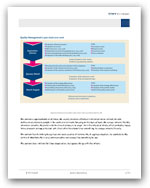Strategic Performance Management for Growth-Driven Businesses
From strategy to results by helping you align vision, teams, and performance through a proven Business Scorecard and BPM framework.
Strategic management is an ongoing process that evaluates and controls the business and the industries in which the company is involved; assesses its competitors and sets goals and strategies to meet all existing and potential competitors.
Why Strategic Performance Management Matters
Many growing organizations in CEEMEA have a clear vision, but struggle to turn it into consistent performance.
We close that gap!
Our Business Performance Management (BPM) method turns your strategy into an actionable roadmap with measurable results.
By combining Scorecards, Process Management and Agile LEAN practices, we enable you to:
-
Translate strategy into clear objectives and KPIs
-
Align teams and departments around shared goals
-
Build dashboards for transparent performance tracking
-
Drive continuous improvement and accountability
Result: Every employee understands how their work supports the bigger picture!
Our Two-Phase Approach
We work with you step-by-step, from strategic design to operational execution.
Phase 1 – Strategy Design & Alignment
-
Assess your current strategy and organizational performance
-
Define key strategic objectives and success factors
-
Develop a Business Scorecard customized to your business
-
Map strategic initiatives and identify performance indicators (KPIs)
Phase 2 – Execution & Continuous Improvement
-
Deploy BPM workflows to streamline execution
-
Integrate performance dashboards and reporting tools
-
Coach leadership and teams to manage by objectives
-
Conduct quarterly reviews to ensure alignment and progress
With our support, strategy becomes a daily management habit @ not an annual presentation.



The Business Performance Scorecard (BPS)
Our proprietary Business Performance Scorecard (BPS) connects Finances with Strategic Directions, Operations and HR.
It enables data-driven decisions and visibility across departments.
Key features:
- Board Leadership & Management performance based on Company’s Critical Success Factors (CSFs)
- Financial planning based on Key Risk Indicators (KRIs)
- Effectiveness and efficiency of internal operations, in Sales, Marketing, IT, Production, Warehouse and Supply Chain/Logistics based on Key Performance Indicators (KPIs)
- Human Resource ongoing improvement based on Personnel Development Plans (PDPs) and
Personnel Annual Reviews (PARs) according to their Competency Job Profiles.
Real-time Data Analytics with our AI Digital Web Applications:
-
Custom KPI dashboards linked to strategic goals
-
Automated tracking of initiatives and deliverables
-
Quarterly review templates for management meetings
-
Visual reporting for better communication and engagement
[Download your free BPS template to evaluate your company’s readiness today].
What You’ll Achieve
By implementing our Strategic Performance Management system, your organization will:
-
Clarify priorities and allocate resources effectively
-
Strengthen accountability and performance culture
-
Improve communication between strategy, finance, and operations
-
Reduce wasted effort and decision bottlenecks
-
Accelerate growth with a unified performance framework
Typical outcomes:
-
Strategy execution improved within 6 months
-
KPI tracking automated across all departments
-
15 – 25 % productivity gain from aligned processes
Why Clients choose Thomas Poutas International Associates
-
Regional expertise: Decades of experience in CEEMEA markets
(Retail, Automotive, Manufacturing, Healthcare, IT, Telco, Services, Public Reforms) -
Integrated methodology: Business Scorecards + BPM + AI Agile Tools = measurable outcomes
-
Tailored delivery: From local SMEs to Multinationals in 14 countries, every solution is customized!
-
End-to-end support: From diagnostic to rollout, training, and ongoing reviews!
“Our strategy was finally visible and measurable. The scorecard clarified priorities across departments.”
— Client feedback, Retail sector (2024)
Let’s Build Your Performance Engine
Strategic business performance is not about complexity, it’s about clarity, focus, and execution with discipline.
We help you create a system that connects your goals to your people, processes, and results.
Ready to make your strategy work for you?